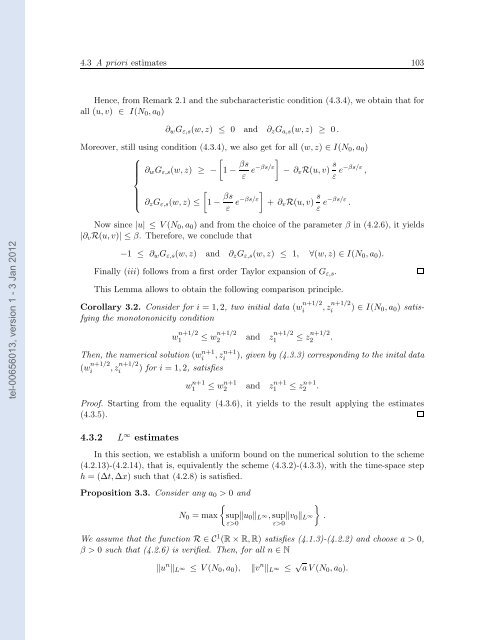Modélisation, analyse mathématique et simulations numériques de ...
Modélisation, analyse mathématique et simulations numériques de ...
Modélisation, analyse mathématique et simulations numériques de ...
You also want an ePaper? Increase the reach of your titles
YUMPU automatically turns print PDFs into web optimized ePapers that Google loves.
tel-00656013, version 1 - 3 Jan 2012<br />
4.3 A priori estimates 103<br />
Hence, from Remark 2.1 and the subcharacteristic condition (4.3.4), we obtain that for<br />
all (u,v) ∈ I(N0,a0)<br />
⎪⎩<br />
∂wGε,s(w,z) ≤ 0 and ∂zGa,s(w,z) ≥ 0.<br />
Moreover, still using condition (4.3.4), we also g<strong>et</strong> for all (w,z) ∈ I(N0,a0)<br />
⎧ <br />
⎪⎨<br />
∂wGε,s(w,z) ≥ − 1− βs<br />
ε e−βs/ε<br />
<br />
− ∂vR(u,v) s<br />
ε e−βs/ε ,<br />
∂zGε,s(w,z) ≤<br />
<br />
1− βs<br />
ε e−βs/ε<br />
<br />
+ ∂vR(u,v) s<br />
ε e−βs/ε .<br />
Now since |u| ≤ V(N0,a0) and from the choice of the param<strong>et</strong>er β in (4.2.6), it yields<br />
|∂vR(u,v)| ≤ β. Therefore, we conclu<strong>de</strong> that<br />
−1 ≤ ∂wGε,s(w,z) and ∂zGε,s(w,z) ≤ 1, ∀(w,z) ∈ I(N0,a0).<br />
Finally (iii) follows from a first or<strong>de</strong>r Taylor expansion of Gε,s.<br />
This Lemma allows to obtain the following comparison principle.<br />
Corollary 3.2. Consi<strong>de</strong>r for i = 1,2, two initial data (w n+1/2<br />
fying the monotononicity condition<br />
w n+1/2<br />
1<br />
≤ w n+1/2<br />
2<br />
and z n+1/2<br />
1<br />
i ,z n+1/2<br />
≤ z n+1/2<br />
2 .<br />
i ) ∈ I(N0,a0) satis-<br />
Then, the numerical solution (w n+1<br />
i ,z n+1<br />
i ), given by (4.3.3) corresponding to the inital data<br />
(w n+1/2<br />
i ,z n+1/2<br />
i ) for i = 1,2, satisfies<br />
w n+1<br />
1<br />
≤ wn+1 2 and z n+1<br />
1 ≤ zn+1 2 .<br />
Proof. Starting from the equality (4.3.6), it yields to the result applying the estimates<br />
(4.3.5).<br />
4.3.2 L ∞ estimates<br />
In this section, we establish a uniform bound on the numerical solution to the scheme<br />
(4.2.13)-(4.2.14), that is, equivalently the scheme (4.3.2)-(4.3.3), with the time-space step<br />
h = (∆t,∆x) such that (4.2.8) is satisfied.<br />
Proposition 3.3. Consi<strong>de</strong>r any a0 > 0 and<br />
<br />
N0 = max supu0L<br />
ε>0<br />
∞,supv0L<br />
ε>0<br />
∞<br />
<br />
.<br />
We assume that the function R ∈ C 1 (R×R,R) satisfies (4.1.3)-(4.2.2) and choose a > 0,<br />
β > 0 such that (4.2.6) is verified. Then, for all n ∈ N<br />
u n L ∞ ≤ V(N0,a0), v n L ∞ ≤ √ aV(N0,a0).

















